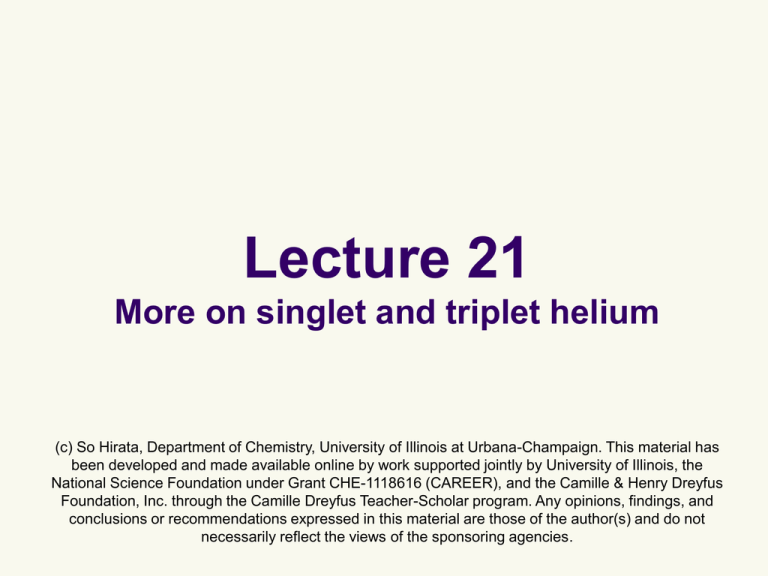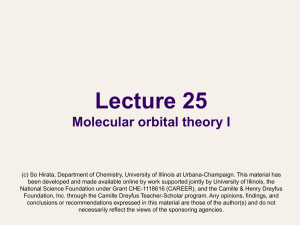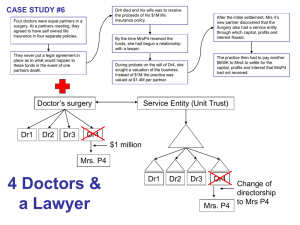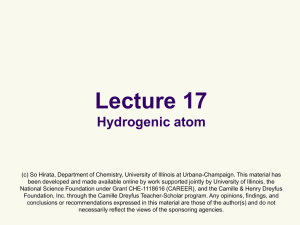CHM 4412 Chapter 13 - University of Illinois at Urbana
advertisement

Lecture 21
More on singlet and triplet helium
(c) So Hirata, Department of Chemistry, University of Illinois at Urbana-Champaign. This material has
been developed and made available online by work supported jointly by University of Illinois, the
National Science Foundation under Grant CHE-1118616 (CAREER), and the Camille & Henry Dreyfus
Foundation, Inc. through the Camille Dreyfus Teacher-Scholar program. Any opinions, findings, and
conclusions or recommendations expressed in this material are those of the author(s) and do not
necessarily reflect the views of the sponsoring agencies.
Singlet and triplet helium
We obtain mathematical explanation to the
shielding and Hund’s rule (spin
correlation or Pauli exclusion principle) as
they apply to the singlet and triplet states of
the helium atom.
We discuss spin angular momenta of these
states and consider the spin multiplicity of a
general atom.
Orbital approximation
The orbital approximation: an approximate or
forced separation of variables
(
)
( ) ( )
Y r1,r2 ,… ,rn » j1 r1 j 2 r2
j n (rn )
We must consider spin and anti-symmetry:
Y ( r1s 1 ,r2s 2 ,… ,rns n ) »
Spin variable
Normalization coefficient Orthonormal
1
n!
A éëj1 ( r1s 1 )j 2 ( r2s 2 ) j n ( rns n ) ùû
Antisymmetrizer that forms an
antisymmetric linear combination
of products
Normalized wave functions in the
orbital approximation
For singlet (1s)2 state of the helium atom:
Y ( r1s 1 ,r2s 2 ) »
=
1
2
Orthonormal
1
2
A éëj1s ( r1a )j1s ( r2b ) ùû
(j (r )a (1)j (r ) b (2) - j (r )a (2)j (r ) b (1))
1s
1
= j1s ( r1 )j1s ( r2 )
1s
1
2
2
1s
2
(a (1)b (2) - b (1)a (2))
1s
1
Normalized wave functions in the
orbital approximation
For triplet (1sα)1(2sα)1 state of the helium
atom:
Y ( r1s 1 ,r2s 2 ) »
=
1
2
=
1
2
A éëj1s ( r1a )j 2s ( r2a ) ùû
1
2
(j (r )a (1)j (r )a (2) - j (r )a (2)j (r )a (1))
(j (r )j (r ) - j (r )j (r ))a (1)a (2)
1s
1
1s
1
2s
2s
2
2
1s
2s
1
1s
2
2
2s
1
Approximate energy
2
2
2e
e
2
2
ˆ
H =Ñ1 Ñ2 +
2m
4pe 0r1 2m
4pe 0 r2 4pe 0r12
2
2e2
2
()
()
Hˆ 1 1
Hˆ 2 2
ˆ dt
E = ò Y HY
*
( )
Hˆ 12 1,2
Energy: (1s)2 helium
2
2
2e
e
Hˆ = Ñ12 Ñ 22 +
2m
4pe 0r1 2m
4pe 0 r2 4pe 0r12
2
2e2
2
()
()
Hˆ 1 1
Y ( r1s 1 ,r2s 2 ) = j1s ( r1 )j1s ( r2 )
Hˆ 2 2
1
2
( )
Hˆ 12 1,2
(a (1)b (2) - a (2)b (1))
Energy: (1s)2 helium
* ˆ
*
ˆ j ( r ) dr j * ( r )j ( r ) dr
Y
H
Ydr
d
s
dr
d
s
=
j
r
H
(
)
ò 1 1 1 2 2 ò 1s 1 1 1s 1 1 ò 1s 2 1s 2 2
(a (1)b (2) - a (2)b (1)) (a (1)b (2) - a (2)b (1)) ds ds
= ò j ( r ) Hˆ j ( r ) dr
1 by normalization
´ò
*
1s
0 by orthogonality
´ 12
*
1
2
1
1 1s
1
1
2
1
2
1
{ ò a (1)a (1)ds ò b (2)b (2)ds
*
*
1
2
+ ò a * (2)a (2)ds 2 ò b * (1)b (1)ds 1
- ò a * (1)b (1)ds 1 ò b * (2)a (2)ds 2 - ò b * (2)a (2)ds 2 ò a * (1)b (1)ds 1
= ò j1s* ( r1 ) Hˆ 1j1s ( r1 ) dr1
}
* ˆ
*
Y
H
Ydr
d
s
dr
d
s
=
j
ò 2 1 1 2 2 ò 1s (r2 ) Hˆ 2j1s (r2 ) dr2
* ˆ
*
*
Y
H
Ydr
d
s
dr
d
s
=
j
r
j
(
)
ò 12 1 1 2 2 ò 1s 1 1s (r2 ) Hˆ 12j1s (r1 )j1s (r2 ) dr1 dr2 = ò j1s (r1 ) Hˆ 12 j1s ( r2 ) dr1 dr2
2
2
Energy: (1s)2 helium
2
2
ì
ü
(1s) energy of
2e
*
2
E = ò j1s ( r1 ) íÑ1 ýj1s ( r1 ) dr1 electron 1
4pe 0 r1 ïþ
ïî 2m
2
2
ì
ü
2e
(1s) energy of
*
2
+ ò j1s ( r2 ) íÑ2 ýj1s ( r2 ) dr2 electron 2
4pe 0r2 ïþ
ïî 2m
2
2
e2
Coulomb repulsion of
+ ò j1s ( r1 )
j1s ( r2 ) dr1 dr2 electrons 1 and 2 –
4pe 0r12
Shielding effect
Probability density of
electrons 1 and 2
Energy: (1sα)1(2sα)1 helium
2
2
2e
e
Hˆ = Ñ12 Ñ 22 +
2m
4pe 0r1 2m
4pe 0 r2 4pe 0r12
2
2e2
2
()
()
Hˆ 1 1
Y ( r1s 1 ,r2s 2 ) =
1
2
( )
Hˆ 2 2
Hˆ 12 1,2
(j (r )j (r ) - j (r )j (r ))a (1)a (2)
1s
1
2s
2
2s
1
1s
2
Energy: (1sα)1(2sα)1 helium
ò Y Hˆ Ydr ds dr ds
=
*
1
1
1
2
2
1
2
{ ò j (r ) Hˆ j (r ) dr ò j (r )j (r ) dr
*
1s
1
1 1s
1
1
*
2s
2
2s
2
2
*
+ ò j 2s
( r1 ) Hˆ 1j 2s ( r1 ) dr1 ò j1s* (r2 )j1s ( r2 ) dr2
*
- ò j1s* ( r1 ) Hˆ 1j 2s ( r1 ) dr1 ò j 2s
(r2 )j1s ( r2 ) dr2
*
- ò j 2s
( r1 ) Hˆ 1j1s ( r1 ) dr1 ò j1s* ( r2 )j 2s ( r2 ) dr2
1 by normalization
´ ò (a (1)a (2) ) (a (1)a (2) ) ds 1ds 2
}
*
0 by orthogonality
=
1
2
{ ò j (r ) Hˆ j (r ) dr + ò j (r ) Hˆ j (r ) dr }
*
1s
1
1 1s
1
*
2s
1
1
1 2s
1
1
´ ò a * (1)a (1)ds 1 ò a * (2)a (2)ds 2
=
* ˆ
Y
ò H2Ydr1ds 1dr2ds 2 =
1
2
1
2
{ ò j (r ) Hˆ j (r ) dr + ò j (r ) Hˆ j (r ) dr }
*
1s
1
1 1s
1
*
2s
1
1
1 2s
1
1
{ ò j (r ) Hˆ j (r ) dr + ò j (r ) Hˆ j (r ) dr }
*
1s
2
2 1s
2
2
*
2s
* ˆ
Y
ò H12Ydr1ds 1dr2 ds 2 = ò j1s (r1 ) Hˆ 12 j1s ( r2 ) dr1 dr2
2
2
2 2s
2
*
- ò j1s* ( r1 )j 2s
(r2 ) Hˆ 12j2s ( r1 )j1s (r2 ) dr1 dr2
2
2
Energy: (1sα)1(2sα)1 helium
ì 2 2
2e2 ü
(1s) energy of
E = ò j ( r1 ) íÑ1 j
r
dr
ý 1s ( 1 ) 1 electron 1
4pe 0 r1 ïþ
ïî 2m
2
2
ì
ü
2e
(2s) energy of
*
2
+ ò j 2s ( r2 ) íÑ2 ýj 2s ( r2 ) dr2
electron 2
4pe 0 r2 ïþ
ïî 2m
2
2
e2
+ ò j1s ( r1 )
j 2s ( r2 ) dr1 dr2 Coulomb or
Shielding effect
4pe 0r12
*
1s
*
- ò j1s* ( r1 )j 2s
( r2 )
e2
4pe 0 r12
j 2s ( r1 )j1s ( r2 ) dr1 dr2
Exchange term– lowers the energy only
when two spins are the same (Hund’s rule)
Total spins of singlet and triplet
Singlet
Sym.
{
}
Antisym.
Y ( r1 ,r2 ) µ j1 ( r1 )j 2 ( r2 ) + j1 ( r2 )j 2 ( r1 ) {a (1)b (2) - b (1)a (2)}
Triplet
Antisym.
Sym.
{
}
Y ( r ,r ) µ {j ( r )j ( r ) - j ( r )j ( r )} b (1)b (2)
Y ( r ,r ) µ {j ( r )j ( r ) - j ( r )j ( r )} {a (1)b (2) + b (1)a (2)}
Y ( r1 ,r2 ) µ j1 ( r1 )j 2 ( r2 ) - j1 ( r2 )j 2 ( r1 ) a (1)a (2)
1
2
1
1
2
2
1
2
2
1
1
2
1
1
2
2
1
2
2
1
Spin operators
Spin angular momentum operators
1æ 1 ö 2
2
sˆ (1)a (1) = ç + 1÷ a (1)
sˆz (1) a (1) = a (1)
2è 2 ø
2
sˆz (1) b (1) = - b (1)
2
1æ 1 ö
sˆ (1) b (1) = ç + 1÷
2è 2 ø
2
2
b (1)
Total z-component spin angular momentum
operator:
Sˆz = sˆz (1) + sˆz ( 2)
Total spin of singlet
{
}
Y ( r1 ,r2 ) µ j1 ( r1 )j 2 ( r2 ) + j1 ( r2 )j 2 ( r1 ) {a (1)b (2) - b (1)a (2)}
Sˆz {a (1)b (2) - b (1)a (2)} = { sˆz (1) + sˆz (2)} {a (1)b (2) - b (1)a (2)}
= { sˆz (1)a (1)} b (2) - { sˆz (1)b (1)}a (2)
+a (1) { sˆz (2)b (2)} - b (1) { sˆz (2)a (2)}
ì
ü
ì
ü
= í a (1) ý b (2) - í- b (1) ýa (2)
î2
þ
î 2
þ
ì
ü
ì
ü
+a (1) í- b (2) ý - b (1) í a (2) ý
î 2
þ
î2
þ
=0
{a (1)b (2) - b (1)a (2)}
Total spin of singlet
MS = 0
2s
S =0
1s
Singlet
Sˆz {a (1)b (2) - b (1)a (2)} = 0 {a (1)b (2) - b (1)a (2)}
Sˆ 2 {a (1)b (2) - b (1)a (2)} = 0 ( 0 +1)
2
{a (1)b (2) - b (1)a (2)}
Total spins of triplet
Y ( r ,r ) µ {j ( r )j ( r ) - j ( r )j ( r )} a (1)a (2)
Y ( r ,r ) µ {j ( r )j ( r ) - j ( r )j ( r )} b (1)b (2)
Y ( r ,r ) µ {j ( r )j ( r ) - j ( r )j ( r )} {a (1)b (2) + b (1)a (2)}
1
2
1
1
2
2
1
2
2
1
1
2
1
1
2
2
1
2
2
1
1
2
1
1
2
2
1
2
2
1
Sˆza (1)a (2) = { sˆz (1) + sˆz (2)} a (1)a (2)
ì
ü
ì
ü
= í a (1) ýa (2) + a (1) í a (2) ý = a (1)a (2)
î2
þ
î2
þ
Sˆz b (1)b (2) = { sˆz (1) + sˆz (2)} b (1)b (2)
= - b (1)b (2)
Sˆz {a (1)b (2) + b (1)a (2)} = { sˆz (1) + sˆz (2)} {a (1)b (2) + b (1)a (2)}
=0
{a (1)b (2) + b (1)a (2)}
Total spin of triplet
M S = 1,0,-1
S =1
2s
1s
Sˆza (1)a (2) = a (1)a (2)
Sˆ b (1)b (2) = - b (1)b (2)
z
Sˆz {a (1)b (2) + b (1)a (2)} = 0
Triplet
{a (1)b (2) + b (1)a (2)}
ì
a (1)a (2)
ï
2ï
ˆ
S í
= 1(1+ 1)
b (1)b (2)
ï a (1)b (2) + b (1)a (2)
ïî
ì
a (1)a (2)
ï
2ï
b (1)b (2)
í
ï a (1)b (2) + b (1)a (2)
ïî
Spin multiplicity
S=0
S=½
S=1
S = 1½
: singlet (even number of electrons)
: doublet (odd)
: triplet (even)
: quartet (odd)
All radiative transitions between states with
different spin multiplicities are forbidden.
Atoms with S > 0 are magnetic and highly
degenerate.
Summary
The expectation value of the Hamiltonian in
the normalized, antisymmetric wave function
of the helium atom is a good approximation
to its energy.
It mathematically explains the shielding and
spin correlation effects.
Total spin angular momenta of the helium
atom in the singlet and triplet states are
obtained. The concept of the spin
multiplicity is introduced.








